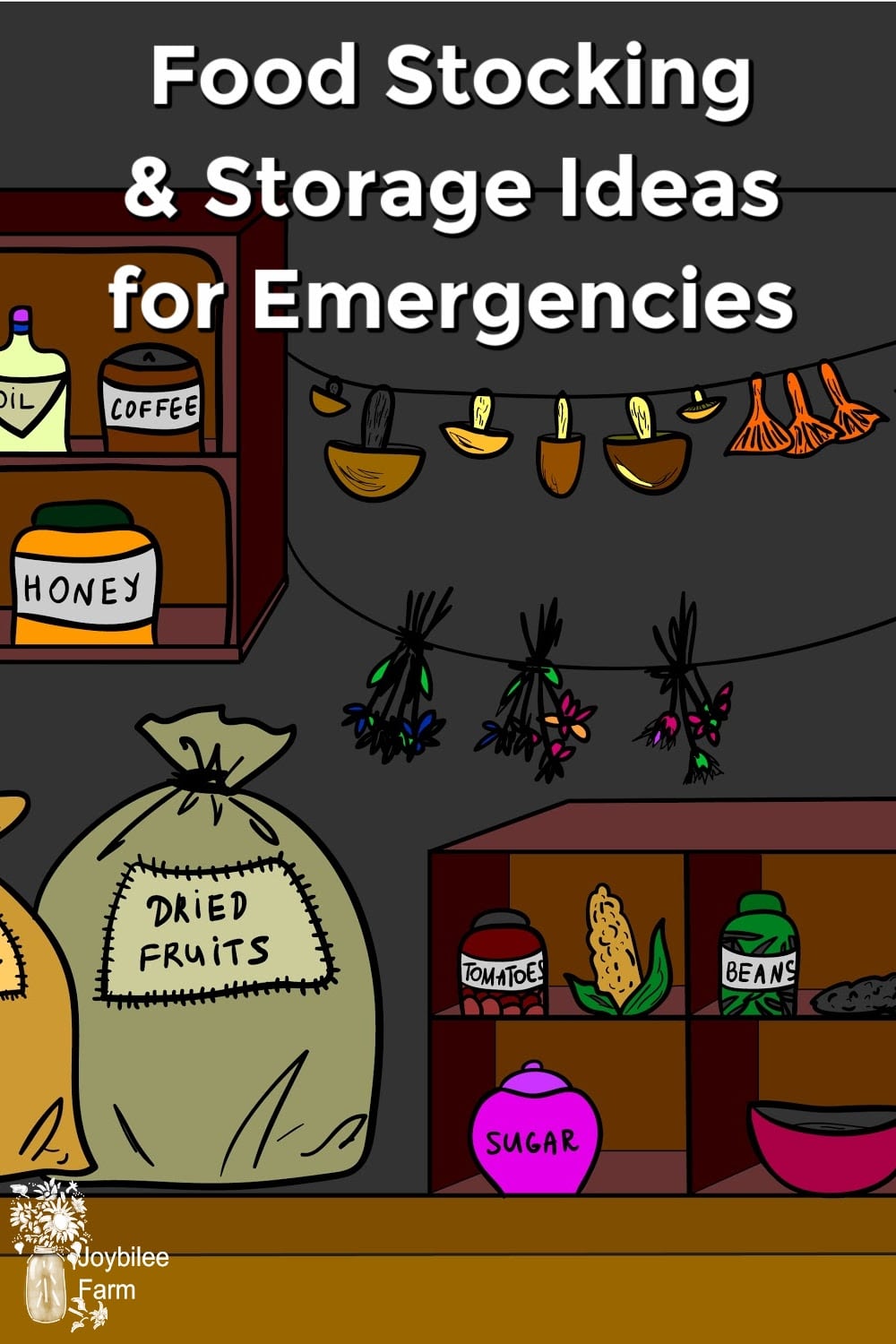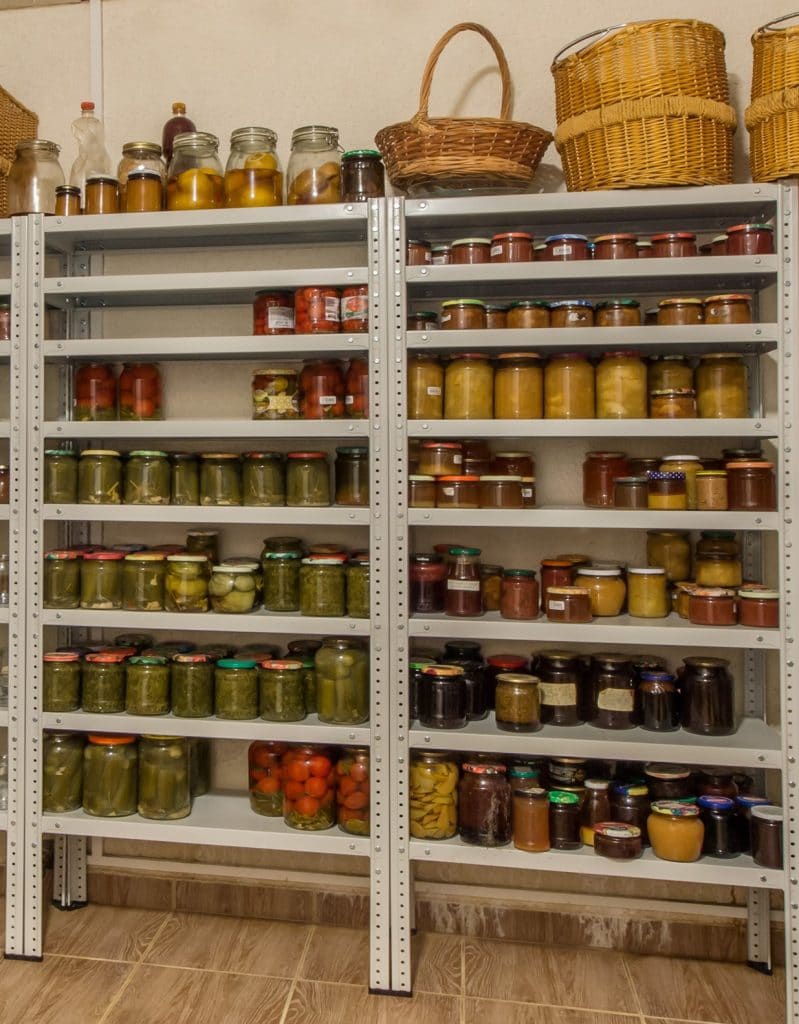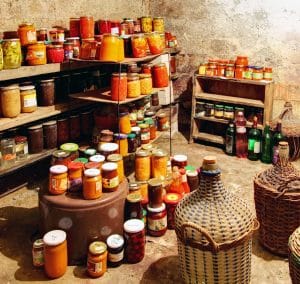Low-Cost Food Storage to Save You Money and Time
What food do you need to stock up on? How do you store it safely? What emergency preparations has your family made? See how my family prepares each year.

Yesterday I talked about the basics for deciding what you need to stock up on for the winter. If you’ve never thought about stocking up food for winter before, I hope you won’t be discouraged at the task. Today I’m inviting you into my home to have a look through my food storage. So grab a coffee and come for a visit.
I hope you’ll see that the task of stocking food for any unforeseen emergency is not difficult. A lot of food can be stored in a small space. I use the utility room of my home because it has no outside wall and stays cool, year-round. I also have a couple of cans that I store in an unheated hallway. If you are using smaller buckets — you can put them in closets, under beds, or under the stairs. Most homes have empty spaces that can be used to store food.
Here are some good reasons to begin stocking food today:
- By starting now, you will be prepared for winter – whether your winter is 3 months or 10 months.
- You will save money by buying food in bulk, while the new crops are coming in.
- Your food will be fresher — prepackaged food relies on ingredients that have no shelf life.
- Your carbon footprint will be smaller.
- You will make fewer trips to the store, saving money on gas.
- You will reduce your waste from excess packaging.
- And you will be prepared for personal emergencies, inflation, supply crisis, winter road closures and disasters.
- You will also be able to avoid hidden GMOs in your food, by cooking from scratch and choosing foods that have never been genetically modified.
- By investing a bit of time this fall, you will save time year-round, by shopping less often, and you will have more time to devote to the things you love to do.
Where do you begin?
Use yesterday’s list of the basic 2500 calorie diet and do the math to figure out how much food you need for each person in your household — add a fudge factor for unexpected guests or unexpected events.
Here’s the break down again — per adult per day:
1 lb. grain (2 cups dry)
1/2 lb. beans, meat, fish (1 can) or eggs (4) or 1/4 lb. cheese
2 oz. nuts/seeds/nut butters (2 tbsp.)
6 oz. dried or 1 1/2 lb. of vegetables and fruit
Sugars, condiments and spices as needed by your own cultural diet.
Winter’s coming: What food do you need to stock up on?
At 2,700 feet we can’t grow everything that we eat by ourselves. For us, winter lasts until we are eating from our garden again — from October to June — 10 months. We don’t store eggs — our hens lay a few eggs year-round and their flush of Spring joy will bring us regular eggs again in March.
As you decide how much food you need to stock up on, plan for your own comfort level whether that’s 3 months or up to 12 months. Here’s what we purchase for a 10-month food supply. Keep in mind the rule that everything you buy or preserve is food your family eats now — there’s no room for dehydrated emergency rations in this plan.
Buying food bulk in full bags saves money. I get mine in at Springfield Bulk Food in Kelowna. The full bag savings is up to 40%. You may have a food co-op near you that will sell full bags. If you don’t need a full bag, partner with few friends to take advantage of the savings.
I store my dry food staples in metal garbage cans in the cold storage room — metal garbage can hold 100 lbs: Ice cream pails with lids from your local ice cream store or plastic buckets with lids from your bulk food store work well, too. The container needs to keep bugs and mice out of your food. It needs to keep the food dry, too.
This is what my family’s list looks like:
200 lbs of dried beans and peas (red kidney beans, chickpeas and our own field peas — will last us 3 years — If you are vegetarian this will last only a year. Beans keep indefinitely)
200 lbs. of big flaked oatmeal (we use this for livestock feed as well as granola, oatmeal and muesli)
100 lbs. wheat berries (hard winter wheat seed for sprouting, grinding into flour or planting)
6 – 10 kg. bags of brown rice (we use 1 bag a month, as we use a bag, I’ll replace it)
50 lbs. hulled sunflower seeds
50 lbs. of whole flaxseed (grind as needed, store ground flax in the fridge)
6 – 2 lb. bags of organic, fair-trade coffee (as we use a bag, I’ll replace it. Coffee prices fluctuate so try to buy when the price is down).
20 kg. sugar
2 kg. yeast
2 kg. baking powder
20 kg. baking soda (used for baking, for livestock, for teeth brushing and for cleaning)
6 – 10 kg. bags of Roger’s Whole Wheat and 2 bags Bread Machine Flour (I’m waiting till the end of Sept. to get the flour — when the new wheat crop comes in, the older wheat goes on sale.)
6 litres dark, organic maple syrup — sold in glass bottles.
10 kg. pail of local honey (Use local, unpasteurized honey to gain the immune-enhancing benefits)
5 kg. of organic peanut butter (only 1 family member eats it)
1/8 lb. of oil/butter per person per day — (coconut oil stores for 2 years, olive oil is stable for a year.)
8 – 500 gram bags of Celtic Sea Salt (I’d buy it in a bigger package but I haven’t found it in bulk).
20 kg. iodized salt (for livestock supplement and salting hides, we don’t eat this)
The seeds for sprouting: Kale, alfalfa, radish, wheat, adzuki beans — about 1 lb. each
Spices: whole pepper, whole mustard, cinnamon, nutmeg, cumin, turmeric, chilli pepper, ginger, basil (100 grams each) Oregano, sage, basil, chives (from the garden)
Herbal teas: peppermint, lemon balm (dried herbs from the garden)
500 gram Boxed tea: Green, and Earl Grey
Dried vegetables for soup (from my garden or the farmer’s market) beans, broccoli, cauliflower, tomatoes, peas, carrots, beets, zucchini, squash. I store these in Ziploc bags inside one garbage can.
Root cellared vegetables (from my garden or the market) carrots, beets, potatoes, winter radishes, turnips, squash, onions, garlic
Fermented vegetables: sauerkraut (cabbage), Kvass (beets), Kimchi (cabbage, radish, peppers and garlic) (made as the crop of vegetables ripen)
Canned vegetables: beans, tomatoes,
Canned meat: soup stock, boneless meat,
Dried fruit: plums, apples, pears, apricots, cherries, grapes (stored in plastic bags inside a metal garbage can or food-grade plastic bucket)
Canned fruit: peaches, apple sauce, apple juice, lemon juice
Root cellared fruit: apples, winter pears
Various jam, chutney, salsa and tomato sauce
Oils: Olive oil, extra-virgin olive oil, coconut oil, toasted sesame oil
White vinegar, balsamic vinegar, cider vinegar
Frozen: Goat cheese, broccoli, peppers, meat, milk, butter
Produce from our livestock, fresh as needed: Meat, eggs, milk
Most of this food will fit on shelves in our cold storage room, or in metal garbage cans in the hallway.
You won’t copy my food stocking and storage system — the gist is to buy the food you already use, in larger amounts and store it for the winter.
I don’t buy canned vegetables, soups, pasta, mayonnaise or salad dressing. I prefer to make my own from scratch. If these are a regular part of your diet, buy extra when the case-lot sale goes on in the fall and store it. Or learn how to make your own, from scratch, using your staples.
I’m not suggesting your copy my list, but rather, look at the foods that you eat every day and figure out what food your own family will need to stock to get through 3 months, 6 months, 8 months, a year — until your garden is producing next summer. And begin preparing today. Pick one thing to do each day and by the middle of October, you will be set.
Don’t think you can afford to stock up on food? Can you take any of the foods that you buy regularly now, mayonnaise, salad dressing, canned beans, for instance, and make them from scratch? Take the money that you saved by making them from scratch and put it toward some bulk purchases.
Tomorrow I’ll share a few camping recipes that you can make up and put in your 72-hour emergency preparedness kit. And I’ll share my list and let you see what’s in our 72-hour emergency kit.
Here are some resources that will help you explore this topic further:
How to Develop a Low-Cost Family Food-Storage System
Emergency Food Storage & Survival Handbook: Everything You Need to Know to Keep Your Family Safe in a Crisis

Is this your first time here? This website is about helping you gain a more creative, self-sufficient, sustainable, exceptional life. We strive to give you tools and information to save you time and money so that you can spend more time doing what you love, where you want to live.
Have I missed anything? What is essential to your winter preparations? What’s preventing you from stocking food for winter or preparing for an emergency? Leave a comment.






What an awesome post. Great lists & information! Love it!
Glad you liked it. Thanks for stopping by. Chris
Hi Chris,
Thank you for this!
Doesn’t storing grain in a metal can still allow bugs in? It doesn’t appear to be too airtight.
Jackie
Hi, Jackie
Yes, storing it in a metal can could potentially allow bugs in. However, I’ve never had bugs in my metal cans, ever, in 30 years of doing it this way. But I may just be lucky. It does keep mice and other rodents out, though. If you are in an area with warmer winter temperatures you can go with air tight plastic buckets, glass jars, etc. Thanks for your other message, too. Nice to hear from you twice today. Have a lovely day, Chris
Thanks for sharing. What a peslaure to read!